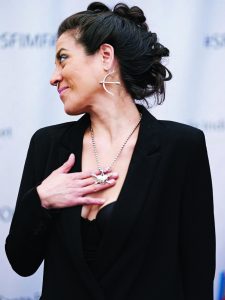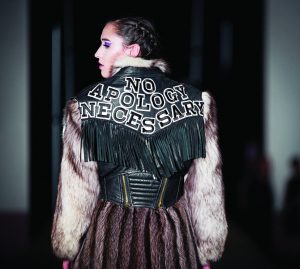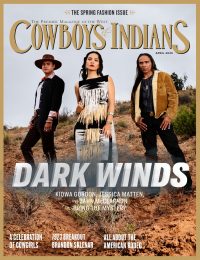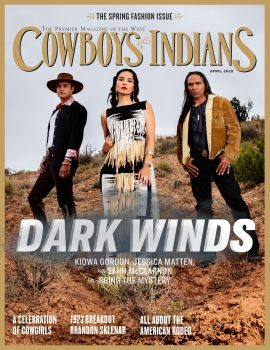In the run-up to one of August’s hottest tickets, Indian Market haute couture show producer and Native Art Historian Amber-Dawn Bear Robe talks Indigenous fashion, diversity, and Santa Fe.
Amber-Dawn Bear Robe is busy. Seriously busy. When the art curator and Native art historian takes precious time to talk about the upcoming Indian Market Haute Couture Fashion Show she’s producing for the Southwestern Association for Indian Arts in Santa Fe, she’s also in the middle of working on a fashion show with Beyond Buckskin at Vital Spaces during the Gathering of Nations, orchestrating an art opening, and being a professor at Institute of American Indian Arts, where she teaches Native American art history, contemporary Native art, history of photography, and history of Indigenous fashion. Additionally, she’s juggling writing an essay about the Indigenous printmaking movement and organizing an editorial shoot for a fashion feature in Native American Art Magazine.
“I do work a lot. It’s my life,” Bear Robe says matter-of-factly. You might find her working around her adopted city of Santa Fe in any number of places where she holes up to get things done: her SWAIA office, her IAIA office, and, she adds with just the slightest hint of irony, the Noisy Water Winery.
Some of the designers in the sixth annual haute couture show, which takes place August 18, are returning from previous years; some are new. Patricia Michaels (Taos Pueblo), Sho Sho Esquiro (Kaska Dene from the Yukon Territory, Cree), and Pamela Baker (First Nations Kwagiulth/Squamish) will be there too, among others. “The SWAIA show is set apart from any other due to the fact that the event shows Indigenous designers from both Canada and United States, and it will eventually include designers from other regions of the global Indigenous world such as Shona Tawhiao from New Zealand,” Bear Robe says. “It’s absolutely grown to one of the biggest attended events of market.”
We talked with Bear Robe, who is Blackfoot from Siksika Nation, about Indigenous fashion, the Indian Market show, and getting creative in Santa Fe.
Cowboys & Indians: We’re talking in the run-up to Indian Market, which has “honoring strength and resilience of Native women” as its theme and is a huge event in Santa Fe every August. Who are the designers in  this year’s show?
this year’s show?
Amber-Dawn Bear Robe: An exciting lineup of 10 designers is showing in this year’s SWAIA fashion show. Korina Emmerich, a contestant on Project Runway Season 13 and founder of New York-based womenswear and accessory brand EMME, is the latest addition to the show. For the first time, Shy Natives designs, by Northern Cheyenne sisters Jordan and Madison Craig, will be walking the runway with fun and flirty handmade lingerie. I am thrilled to have Catherine Blackburn’s New Age Warriors line in the show. Canadian-based designer Lesley Hampton, who focuses on body positivity, is another newbie to the show, as well as Delina White of the label I Am Anishinaabe.
Trailblazers of the SWAIA runway who always wow the audience are Patricia Michaels, Donna and Jason Brown of the brand Decontie & Brown, Pamela Baker, and Sho Sho Esquiro. These and other designers are Indigenizing fashion by creating looks inspired by their culture, while extending beyond the expectation of “Indian” design. Native style is always changing and unique to each area, artist, and designer.
C&I: What kinds of trends are you seeing?
Bear Robe: Lots of color, big Indigenous bling like beaded earrings, dentalium shell work, and medallions.
C&I: Are there characteristics of “Native” fashion that these designers share?
Bear Robe: All designers are different. One commonality is the practice of non-Native designers appropriating original Indigenous designs and fashion. Appropriation of Indigenous design has been happening for decades, but it has been getting attention recently due to individuals speaking out about the issue, such as Jessica Metcalfe from Beyond Buckskin and Adrienne Keene of Native Appropriations. Additionally, articles such as this. Currently, I am a guest editor for the Walker Art Center’s digital magazine, Walker Reader. The topic is “How can fashion be Indigenized?”
C&I: What’s the atmosphere of the show like?
Bear Robe: The atmosphere is always high-energy, exciting, and vibrant with some people lining up hours beforehand to get a standing-room view for those who did not purchase a ticket before selling out. There is a pre-party with champagne and hors d’oeuvres for VIPs. VIP tickets are for special guests, with limited VIP tickets for sale, which guarantees you a front- or second-row seat to see the show. Santa Fe has its local celebrities who frequent the SWAIA fashion show and who may sometimes even be in the actual show. Last year, actor Wes Studi modeled for designer Cody Sanderson.
There is also a VIP after-party where guests can meet, mingle, and share a glass of vino with the designers and models. DJ Celeste Worl has been performing for most of the fashion shows I produce.
C&I: What’s the most exciting aspect for you?
Bear Robe: Being surrounded with the huge rush of creative and eclectic personalities is amazing. Energy is high and intoxicating. The fashion shows are also my time to gather with lifetime friends, meet new friends, and to be engaged with the Santa Fe artistic and Indigenous communities.
C&I: How can art — fashion included — be a bridge to understanding among different cultures?
Bear Robe: I’m an art curator and Native art historian. When I direct and produce fashion shows, it’s an extension of my curatorial field. Art and fashion go hand in hand. Indigenous fashion has always been an important part of all the various and diverse Indigenous nations in the U.S. and Canada.
Native fashion, clothing, adornment, and everyday objects are historical and prevail as unique, handmade, and one of a kind. Grandma Bear Robe beaded all the outfits for my family, father, grandma, auntie, etc. From my earliest memories, art has been present in the everyday. It has always been a part of a living, breathing, ever-changing culture of Indigenous cultures. Native fashion now has a platform it hasn’t before, but irreplaceable, original designs and fashions have always been part of Indigenous culture.
Contemporary and historical Native North American fashion and art may be based on tradition and culture, but it’s a living and breathing entity, always changing. Culture is fluid for Indigenous peoples just like it is for everybody else. I avoid using the words traditional or authentic. As an educator, I try not to use the terms due to the connotations attached. Generally, when people put traditional and Indian together, an image of the historic Indian of the past comes to mind, squeezing out room for the modern-day realities and individual Indigenous person.
My focus in any project I am involved with is representing an Indigenous perspective, including, as much as possible, the vast diversity of Native perspectives. Not one Native person can speak to all of Native North America. Northwest Coast nations are completely different from the Pueblo peoples of the Southwest, and so on. North America and its original peoples are beautifully diverse and culturally rich. The history of Native North America is largely unknown to people who actually live in Canada and the United States.

C&I: You have strong feelings about this.
Bear Robe: I am very opinionated in terms of Indigenous arts culture, but that’s also the Canadian in me. The Canadian Indigenous voice is strong, with an everyday presence and multiple platforms, compared to the little presence of the Native voice in America. For example, the awareness of African American issues, historical and present, is very prominent in the United States. That type of awareness is addressed to First Nations, Indigenous, Métis, and Inuit people of Canada. I am surprised at how many Americans think Indians no longer exist. Or have no idea of the colonizing, genocidal past of what we now call America.
C&I: Given fashion’s outsize carbon footprint and waste, what impulses toward sustainability are you seeing among Native designers?
Bear Robe: I would recommend asking a designer about this particular question. But there’s a great quote from Meghann O’Brien — you can find it on her website at meghannobrien.com — that I’d like to share. She has been in my previous fashion shows and is currently in Santa Fe doing a fellowship at the School for Advanced Research.
“The idea of clothing and textiles containing meaning and power has been held by every indigenous group around the world. As fast fashion and consumption of cheaply made garments continues to escalate, we find ourselves in a world where clothing has become more disposable. In fact the fashion and textile industry is now among the top polluting industries in the world. Indigenous worldview and values have the potential to bring back the idea of clothing having meaning and power. Equally, the fashion world has the potential to give renewed relevance for our worldview in a contemporary context, without having to alter the techniques and materials. To me this is an amazing merging of two seemingly distant worlds, each with the potential to recontextualize, transform, and inform the other.”
C&I: That’s a great thought to leave people with, but one last question: What final thing about the show and Native fashion do you really want people to understand?
Bear Robe: People are now paying attention to Indigenous fashion. Indigenous design is the original “haute couture” of what we now call Canada and the United States. For example, powwow regalia is all original, unique, and handmade, while representing the artistic language of each bead worker and creator. Powwow style and dress is continually changing, signifying the now and present. Additionally, one Indigenous designer, Native tribe, or nation does not represent or speak for all of Native North America.
The SWAIA fashion shows — any show I produce, including the curation of art shows — feature designers and artists who are not bound by conventions or expectations of what “Indian” art or dress is or should be. The goal is to support and foster Indigenous expression free from rules and regulations that have been placed on Native North American artists since colonial contact.
This year’s SWAIA Haute Couture Fashion Show takes place during Indian Market August 18 at the Santa Fe Community Convention Center. Tickets can be purchased at swaia.org (they go fast!). If you can’t make it in person, the show will be live-streamed at their website.
Photography: Jason Ordaz/Courtesy Amber-Dawn Bear Robe, (Middle Image) Courtesy Amber-Dawn Bear Robe
From the August/September 2019 issue.












